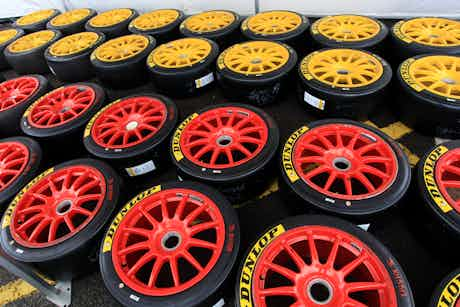What do EU tyre labels mean?
January 16, 2015 by carwow staff

From 1 November 2012, each new tyre sold in the EU has to carry a label describing its performance in three key areas: fuel efficiency, wet braking performance and how much noise they give off when on the road.
The European Commission introduced the law to demystify the tyre rating process, to help consumers make an informed choice about what tyre they need and to form a standard of comparison so consumers can see which tyres are better or worse.
Ratings, like those for homes or electrical appliances, are from A to G with A being the best. The labels look like this:
Fuel efficiency
As a tyre rotates along the road the weight of the vehicle it’s attached to presses it into the surface. This causes friction between the tyre and the road surface, which can increase a tyre’s rolling resistance (its tendency to stop spinning) therefore increasing fuel consumption.
Low-rolling-resistance tyres are popular on eco-friendly cars because, as the name implies, they resist the slowing force of friction and take less energy to keep spinning. Tyres are rated from A to G and the experts at TyreSafe suggest that A-rated tyres can reduce fuel consumption by 7.5 per cent compared to G-rated ones.
A word of caution – low-rolling-resistance tyres are excellent on efficient cars but are nowhere-near as suitable for performance applications. Faster, heavier cars require much more rubber to be able to stop and corner safely so tyres with more grip and resistance are usually specified instead.

Wet braking performance
Braking takes much longer in the wet because waterlogged roads have less grip than dry ones. Like the soles of your shoes, tyres have grooves in them to help them perform properly in the rain. The patterns and sizes of these grooves are key to a tyre’s wet braking performance.
Larger grooves will encourage more surface water into them, meaning less water stays between the tyre and the road surface, thus improving wet braking. This is a balance, however, because the more grooves you make, the less rubber you have to actually grip the road surface.
Experts at TyreSafe reckon that four tyres rated A for wet braking will come to a halt from 50mph 18 metres before G-rated ones. We suggest you pick the best wet braking performance you can afford for your car – we get a lot of rain in the UK so it pays to be prepared.

Exterior noise emissions
Noise pollution is a growing problem in big cities and, as more and more of us seek to get mobile, the amount of noise tyres in traffic give off can seriously compromise local residents’ quality of life. For those inside the cabin, tyre roar can turn a long journey into a full-on ordeal.
Tyre noise is rated by a decibel readout and, to put that figure into context, three black waves. Tyres with three waves will produce the most noise and those with one wave produce the least. We can’t really think of any trade-off for quieter tyres, assuming all other factors are the same, so we’d suggest getting the quietest you can.
Phew, that was tyring…
Yes – tyres can be complex and might not always seem that important but, remember, they’re the only things holding your car on the road so it’s utterly essential they’re safe, legal and appropriate for your vehicle. If you’re not sure what tyres you need or if you need replacements – go to a reputable tyre shop and get advice from a professional.
















